Why is America’s most successful bike share program in…Washington, DC?

by Tom Vanderbilt
Published in Slate
January 7, 2013
If you had been handed, a decade ago, a map of the U.S. and asked to predict where the novel idea of bike sharing—then limited to a few small-scale projects in a handful of European cities, might first find its firmest footing, you probably would have laid your money on a progressive hub like Portland or Seattle or the regional poles of walkable urbanism, New York or San Francisco—all of which were scoring higher, those days, in surveys like Bicycling magazine’s list of most bikeable cities. But today, the nation’s largest, most successful bike-share program—in terms of size, ridership, and financial viability—is in Washington, D.C.
…In D.C., Gabe Klein, a former VP at car-sharing pioneer ZipCar and political neophyte, was appointed head of the [Washington DC] DOT [in 2008]. He had an “action agenda,” as he calls it, with more than 100 items on it—one of which was to launch a larger bike-share system. “Having come from ZipCar,” says Klein, now transportation commissioner for the city of Chicago (which, like New York, is launching a big bike-share system this spring), “I knew that any sort of nodal business was only as effective as the number of nodes you have.” While SmartBike was useful in terms of getting early adopters onboard and the public used to the idea, it was a trip to Montreal, with its Bixi system, that hinted at what a bike-share system could look like. SmartBike stations, Klein says, “were a construction project. It took months. You had to get PEPCO [the local electrical utility] out there, it had to be wired.” Bixi’s stations, by contrast, were solar-powered and modular. Where it could take three months to build a SmartBike station, Bixi stations could be set up in three days.
Read entire article from Slate magazine HERE>>>
RELATED:
• The Best Bike-Sharing Program in the United States





